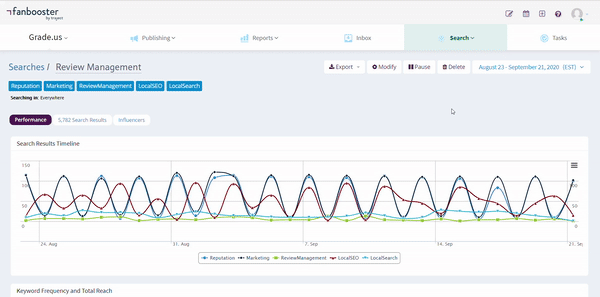Social listening is an aspect of social media customer relationship management that often flies under the radar. Many businesses spend so much time thinking about what to say and how to appear on social media that they forget the people on the other end.
Ironic, isn’t it?
As a social media manager, some of your most important work hours will be spent getting familiar with your customers. That’s where social listening will come into play. In time, as you come to better understand them, you’ll be more prepared to create content and messaging that engages, delights, and inspires them.
You will also find that social media is a customer service channel, whether you like it or not. The ultimate choice belongs to their followers.
If social media serves as a direct line between businesses and the masses, customers are picking up the phone. If you’re a social media management agency, your client should be, too.
Communicate the value of social listening to your clients early and often — during the social media proposal stage and throughout your relationship. Explain social listening and how it can be leveraged to keep customers happy.
Table of Contents
Start your free 14-day Fanbooster trial
What is Social Listening?
Social listening is a social media community management tactic. Marketing teams utilize software tools to monitor keywords, brand mentions, and sentiment across channels to better understand the needs of their customer base.
Social listening can shape messaging — influencing content strategy, sales positioning, customer support, and more. Social media listening tells you what your customers want in a product, service, or other offering and why they want it. It can also be the impetus to take action when there’s an opportunity to create a better relationship with a customer.
What's the difference between social media monitoring and listening?
Did an elementary school teacher ever tell you that there’s a difference between listening and really listening?
What does that mean? There’s a difference between smiling and nodding along with a conversation and actually thinking through a conversation, articulating your thoughts, and giving a meaningful response or learning something from it.
That’s very similar to the difference between social media monitoring and social media listening.
Social media monitoring is—more often than not—waiting for a problem to arise, responding to it, and moving on. Social media monitoring is reactive. For example, if a customer has an issue with your website, you monitor for that tweet and respond with a solution.
But social media listening is proactive. It requires intuition, analysis, and action.
With social listening, you actively keep tabs on industry hashtags, keywords, and competitor accounts. Setting aside time in the day, you purposefully read through matching tweets, pins, and other social posts to see what you can learn from them and how you can improve your own messaging and social media activity.
For example, social listening can include searching for content like:
- Your brand name and social media account handles (ex: Fanbooster)
- Product names and misspellings (ex: Fanbooster scheduling, Fanboo, Fan Booster)
- Company slogans and nicknames
- Competitor names and related keywords (ex: Hootsuite, Buffer)
- Generic industry hashtags (ex: #SocialMediaManagement #SMM)
- Industry keywords, phrases, and buzzwords (#Social #SocialMediaTips)
Find trends within these search results and use them to harden your product offering, keep up with cutting-edge new trends, and otherwise ensure your social media is running smoothly.
For example, if you’re a coffee company, you’ll likely want to run searches for your brand’s name, different blends of coffee, “[your city name]’s best coffee shops”, competitor coffee shop names, and more.


Then, read through these results and see what insights you can pull from them. Maybe you’ll see that local coffee-holics love a type of specialty latte at your competitor’s shop, but hate their new breakfast sandwiches.
You might learn that a specific part of town has no good coffee shops, uncovering a possible new location for your shop.
These insights can impact how you’re marketing, what features/highlights to showcase, and what you can act on to help your clients improve their own business.
What can your brand learn from social listening?
1. Discover your audience demographics


Keep an eye on who is talking about your brand, related products, and competitors.
Look at their location, age, and other demographic information.
When you understand the people that already make up your audience, you’re learning about some of your ideal customers. That allows you to create personas and create new content specific to your client’s audience.
Even better, you can use tools like Fanbooster to pull this demographic information without having to manually search through profiles.
Just make a new search and click on the Performance tab to view age, following, and location data for people using your keywords.
You might learn that a specific part of town has no good coffee shops, uncovering a possible new location for your shop.
These insights can impact how you’re marketing, what features/highlights to showcase, and what you can act on to help your clients improve their own business.

You should still go a step beyond this though.
Look through some individual accounts and try and keep track of common interests. Use this to curate future content and make sure that you’re writing for the right audience.
2. Find influencers in your industry

When social listening, there’s no doubt that you’ll start to see social shares from influencers in the space.
Don’t gloss over these: instead, take note of them.
Follow the popular influencers in your space and pay attention to what they’re talking about.
These people are at the forefront of your industry and there’s no doubt that they’re on the hunt for new trends themselves, so why not capitalize on their research?
Keep these influencers in a database. This will come in handy when you want to start your own influencer marketing campaign.
Fanbooster can help you with this, too.
Just make a new search and click into the Influencers tab. Here you can view people using your keywords the most and the most popular people that have used your keywords.
3. Tweak and adjust your content strategy in real-time with sentiment analysis
Sentiment analysis is a hot topic in 2020 and not something you should ignore.
In short, this is when you run searches for your product names, brand names, and related buzzwords on social media. You can gauge how your client’s audience feels about those topics.
You can—and should—run sentiment analysis on your client’s brand and their products.
Look for what people love and don’t love about their product, and forward it to your client to pass along to their engineering team. This can be an entire framework for new product lines and services.
We recommend treating sentiment analysis like a project. Look for downturns in your client’s brand sentiment, find the root of the problem, and work with them to solve it before it becomes a brand image disaster. They will appreciate your insights.
Further, run sentiment analysis on industry terms and their competitors. You can also use this to find which new industry terms are popular, and which should be avoided—trust us, it’s a lot easier than making the mistakes yourself.
How to maintain positive sentiment on social media
Another benefit of social listening is that it helps clients control their brand’s image. They’re also more able to turn followers into customers and customers into loyal advocates.
For example, consider this response from Sherwin-Williams. Paint providers are a dime a dozen. In thoroughly responding to customer Teri’s question, the brand stays top-of-mind when it’s time to choose new house paint.

A little effort goes a long way, especially among customers trying to connect.
Here are a handful of ways to maintain positive sentiment across social channels:
Talk like a human
Social media is about connection. It’s inherently human and transparent.
If a business makes a mistake or responds to social posts insincerely, people will call them out for it. Every Tweet, wall post, and comment is a public conversation in the making.
When responding on social, listen to what your followers say. Don’t shoot off a generic reply and call it a day.
Even if you’re bombarded with the same questions on repeat, like Altar’d State in the below example, varied responses humanize the brand. It shows consideration for the time someone takes to engage.

Use social media listening tools
With social media’s fast pace, it’s easy to lose track of community chatter when relying on native channel notifications alone. This is why a social media listening tool is a must.
Fanbooster monitoring features make it easy to consolidate your agency’s efforts. Centralize engagement across all your client’s channels into one updated inbox.
You can also set up ongoing keyword searches for topics important to your client’s business. At the very least, set up a search for brand name variations. This helps to account for times when customers fail to tag your business in their social posts.
Take this exchange from Netflix. By tracking mentions of their brand using social media listening, they were able to offer a highly-specific suggestion and drive Stacey Dooley back to their product.

Provide relevant responses
Another benefit of social media listening is the value it provides to your client’s other marketing channels. When you pay attention to the conversations people have around brands and the topics applicable to them, you become familiar with their language and pain points.
Noticing trends as they develop puts your client in a better position to provide useful resources — or products.
The Jobs-to-Be-Done theory (which asks, “What job your product is hired to do?”) beautifully demonstrates the importance of understanding customer needs with their infamous milkshake example. By studying customer behavior trends relative to milkshake sales, McDonald’s not only sold more product, but created a better one — one that served their customers’ needs.
You may be a smaller scale operation, but the theory still holds value. Building a community on social isn’t about making assumptions and churning out generic content. It’s about listening and catering to those you’re most interested in attracting.
Look for proactive opportunities to surprise and delight
Beyond the basics, maintaining positivity on social sometimes requires a bit of creativity.
So be opportunistic about social listening. Pay attention to influential accounts posting about your brand or topics relative to it. Strengthen the relationship by offering free product or commission-based promo codes.
Know when to move the conversation to a private channel
You won’t always be able to keep every conversation light and fluffy. No matter how hard you try, people will complain.
The last thing you want to do is delete every negative comment. Instead, if you notice that responses are getting heated or need specific contact information to move things forward, politely request follow-up through an email or direct message.
Don’t be dismissive but don’t air your client’s dirty laundry either. Keep a positive tone, emphasizing your desire to help.
For more on handling negative social media exchanges between your clients and their customers, check out Jay Baer’s data-backed recommendations in the book Hug Your Haters.

4. Market research for all: find new product ideas right from the source
Market research has long been an expensive and time consuming process.
You need to put together a focus group, compensate participants, and hope that they give you honest responses to your questions.
Thankfully, social listening allows you to accomplish the same goals for your client without the cost and heavy coordination life.
Now all social media users can be your client’s focus group. And the best part? It’s completely free and they don’t know they’re a part of your experiment.
But don’t worry: it isn’t as evil as it sounds.
Just put your ear to the ground and listen for pain points, feature requests, and “wishes” from people in your client’s target industry and demographic.
Take note of these complaints and wishes and use them to improve your product lineup, content offerings, or whatever else you sell and communicate them to your clients.
For example, if you’re a coffee shop, look for social media posts that reference someone’s favorite coffee flavor or type of latte. There’s a good chance that you can move caramel cappuccinos if you see 300 tweets wishing for one.
Once again, you can even use tools like Fanbooster to restrict your searches to a specific location, so you can get hyper-local insights on what people want.
Just make sure this information is shared directly to your clients in an actionable way. After all, finding this data does no good if it never makes it to your client!
5. Find leads for your client and get the green light to start social selling
When running searches for related industry terms, think about intent in your search results. Look for people who indicate they’re looking to make a purchase.
For example, if you’re a car dealer running a local search for “used cars” and “used BMW”, make note of the people that are discussing making this purchase.
Then, when appropriate, reach out to these people and introduce your client’s product. Try and help this person solve their problem with your client’s product.
Make sure to keep a close eye on your social media mentions too.
When you see someone reaching out with a product question, make sure you actively respond and answer their questions. Otherwise, your client’s leads will go cold.
Make social selling easier with Fanbooster’s Tasks feature

Do you work with your client’s sales team? Use Fanbooster’s Tasks feature to delegate tasks.
To do this, just add your sales team as project users so they have access to the Fanbooster dashboard.
Then, when you find a qualified lead in Fanbooster Search, click the blue pin button next to the social media message to open the task creation window.
You can then choose Sales Lead from the task type, choose who you want to assign the task to, and click the Save Task button.
The salesperson will be assigned the message and can reach out directly to the lead directly—no emails, Slack messages, or other communication between sales and marketing teams required.
6. Search outside of traditional social networks

Ready to start social media listening for clients? Great news! Just make sure you’re listening to more than just LinkedIn, Twitter, and Facebook.
Your brand should also be listening to blogs, review sites, and forums sites like Quora and Reddit.
Listening on these sites will give you an informed and well-rounded look at your client’s social media channels and what people think about your client’s products and industry.
One great example of this is Reddit. Keeping an eye on related subreddits can be a great place to gauge opinions on any number of topics in your industry.
For example, if your client sells invoicing software to lawyers, keep an eye on r/lawyers and r/law. Chances are you’ll see lawyers discussing what they love and hate about their current invoicing software.
Further, we’ve found that conversations on Reddit, Quora, and other related sites go much deeper than social media discussions, so you’ll get better insights.
Thankfully, Fanbooster’s social listening tool supports Reddit.
Just add a subreddit of your choice, and you’ll be able to monitor for mentions of keywords of your choice. This will save you time and expand your listening.
How to start social media listening with Fanbooster

Thankfully, you don’t need to run thousands of manual social media searches to start social media listening—just use Fanbooster.
We package a social listening tool with our complete social media management tool. It doesn’t cost any extra to use and it’s included with all of our plans.
We call this tool Search. 🔎
Using this tool, you can create Search Agents that run ongoing searches for up to ten keywords at once. Here’s how:

You can create a search by clicking on the Search button on the toolbar. Then, click the New Search button from the drop-down menu.

Now, fill out your search criteria. Here’s a rundown of all the options on the New Search screen with a quick definition:
- Name – Give search a name.
- Where would you like to search? – Choose whether to search everywhere (all publicly accessible networks) or only within your own networks connected to your Fanbooster account (the people you're following). You can also search within a specific set of RSS feeds.
- What keywords would you like to exclude? – You can exclude specific keywords from your search if you'd like.
- What keywords would you like to search for? – Enter the keywords, hashtags, or social media handles you'd like to search for. You can add any mix of these here.
- Would you like to restrict results by location? – You can search within a specific country with a custom radius of any address worldwide. Just keep in mind not all posts from networks are geotagged, so using this option will reduce the number of results.
Once your search is ready to go, you’re ready to start social listening. Just click the blue Save button at the bottom right-corner of the screen and the search will initialize—your search results will be available in the next hour or so.
Then, monitor your searches regularly. You can export all results to a PDF or Excel document too—just click the export button at the top of the Search Agent’s window.
Final Thoughts: How to leverage social listening & keep your clients’ customers happy
When in doubt, approach every social media conversation as an in-person conversation. How would you treat this stranger professionally if they were standing in front of you?
Define a repository of FAQs (and acceptable answers) with clients, as well as tone before you hop into the community management saddle. The most positive attitude in the world won’t save you from the wrath of angry, Tweeting customers if you don’t have the right tools to mediate the situation.


